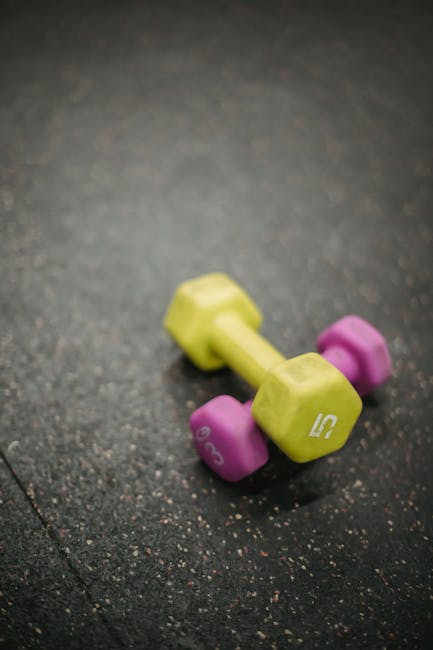Attention all weightlifting warriors! Are you ready to lift some heavy weights, pump some iron, and show off those bulging muscles? Well, before you hit the gym and start bench-pressing like a boss, there’s one thing you need to be aware of – hernias. That’s right folks, those pesky little protrusions that like to make their presence known when we least expect it. But fear not, we’ve got you covered! In this article, we’ll be sharing some safety tips and strategies to help you navigate weightlifting with a hernia. So sit back, relax, and let’s get ready to lift some weights!
Contents
- 1 Weight Lifting with Hernia: Safety Tips & Strategies
- 2 1. Understanding Hernia: Causes, Symptoms, and Risks
- 3
- 4 2. The Importance of a Proper Diagnosis Before Starting Weight Lifting
- 5 3. Suitable Weight Lifting Exercises for People with Hernia
- 6 4. Pre-Lifting Preparation: Preventing Straines and Injuries
- 7 5. Tips for Managing Hernia Symptoms During Weight Lifting Sessions
- 8 Farewell, Hernia!
Weight Lifting with Hernia: Safety Tips & Strategies
Don’t tear your way to a six-pack: Tips & Strategies for lifting with a hernia
It’s a tale of two worlds: On one hand, you’re committed to working hard and getting those toned muscles you’ve always dreamed of. On the other hand, there’s a hernia that’s staring right back at you. How do you reconcile the two? Fear not, brave lifter. Here are some tips and tricks to help you lift with hernia while minimizing the risk of injury.
First and foremost, don’t be a hero. This isn’t the time to try to smash your squat PR or bench press more than you’ve ever lifted before. You’re not invincible, despite what your ego may be telling you. Listen to your body and start with lighter weights, and work your way up gradually. Be sure to keep your movements slow and controlled, and avoid any sudden jerks or twists that could put unnecessary strain on your hernia.
- Start with a proper warm-up. You might feel silly doing your stretches in the corner while everyone else is deadlifting like champs, but trust us, it’s worth it. Focus on gentle movements that stretch the muscles in your core and groin area. Try some pelvic tilts, torso twists, or side lunges to get the blood flowing and loosen up your body.
- Invest in a good support belt. This won’t magically make your hernia go away, but it can provide some extra stability and support for your abdominal muscles. Make sure it’s snug but not too tight, and try to wear it during your entire workout.
- Avoid exercises that put a lot of pressure on your abdominal muscles. This includes moves like crunches, sit-ups, and some forms of deadlifts. Instead, focus on exercises that work your glutes, back, and legs. Squats, lunges, and hip thrusts are all great options.
Remember, the key to lifting with a hernia is to take it slow and steady, and to prioritize safety over brute strength. With a little patience and perseverance, you can still achieve your fitness goals, even with a pesky hernia trying to hold you back. Happy lifting!

1. Understanding Hernia: Causes, Symptoms, and Risks
Let’s be real, no one wants to talk about hernias. It’s like the uninvited guest at a party – always present but never welcomed. But unfortunately, hernias can happen to anyone. So, let’s dive into the world of hernias and understand what causes them, their symptoms, and risks.
- Causes: Hernias are usually caused by a combination of muscle weakness and strain. Anything that increases pressure in the abdomen can cause a hernia, including lifting heavy objects, constipation, or persistent coughing.
- Symptoms: Hernias can cause a bulge or swelling in the affected area, along with discomfort or pain. If the hernia is in the groin area, you may also experience a dull ache and a sensation of heaviness.
- Risks: While hernias are generally not life-threatening, they can lead to complications that require surgery. If left untreated, hernias can cause bowel obstruction or strangulation, which can be serious and require immediate medical attention.
So, next time someone brings up hernias at a party, you can impress them with your knowledge of causes, symptoms, and risks. But let’s hope hernias don’t come up too often at parties – they’re not exactly a conversation starter!
2. The Importance of a Proper Diagnosis Before Starting Weight Lifting
The Importance of a Proper Diagnosis Before Starting Weight Lifting
So, you’ve decided to hit the gym and start lifting those heavy weights? Good for you! But hold on, cowboy. Before you get too excited and start bench pressing your own weight, let’s talk about the importance of getting a proper diagnosis before you begin.
- Identify any pre-existing conditions: It’s important to know if you have any pre-existing injuries or medical conditions that might interfere with your lifting routine. After all, you don’t want to aggravate an old back injury or get a hernia while lifting weights.
- Customize your workout: A proper diagnosis will help you create a customized workout plan that suits your body’s needs and limitations. You might need to avoid certain exercises or use different techniques to prevent injury.
- Maximize your results: Getting a proper diagnosis will help you optimize your workout routine and maximize your results. By identifying your body’s strengths and weaknesses, you can focus on the areas that need improvement and avoid wasting time and energy on exercises that won’t benefit you.
So, the next time you hit the gym, make sure to get a proper diagnosis before you start lifting weights. Your body will thank you for it, and so will your gains.
3. Suitable Weight Lifting Exercises for People with Hernia
So, you’ve got a hernia but still want to pump some iron? No worries, we’ve got you covered with these suitable weight lifting exercises:
- The Dead Bug – Lay on your back and lift your legs and arms up. Slowly lower your right arm and left leg at the same time, then switch sides. Bonus points for making buzzy bug noises.
- The Hulk Smash – Whack a medicine ball against the ground with all of your might. Pretend you’re smashing your hernia into smithereens. Disclaimer: Please don’t actually smash your hernia into smithereens.
- The Grandma Curl – Grab a resistance band and curl your arms up towards your shoulders, as if lifting groceries. Channel your inner grandma at the supermarket.
Remember, always listen to your body and stop if you feel any pain or discomfort. And if someone judges you for doing the Dead Bug on the gym floor, just tell them you’re a method actor preparing for a bug-themed role.
Now go forth and lift (responsibly)!
4. Pre-Lifting Preparation: Preventing Straines and Injuries
While lifting weights can seem like a straightforward activity, it’s not uncommon for people to injure themselves due to poor pre-lifting preparation. Preparing your body before a workout doesn’t have to be a dull chore. By incorporating a few simple steps, you can make sure you avoid strain and injury. Here are some tips to keep you safe:
Firstly, warm up your muscles by doing cardiovascular exercises. Not only will this get your heart pumping, but it will also improve your flexibility, which will help prevent injury. Try jumping jacks, running in place, or jogging on the spot. Aim to get your blood flowing for at least five minutes before you start lifting.
Secondly, don’t forget about stretching. It may seem like a chore, but stretching for a few minutes before your workout will make a huge difference. Pay particular attention to the muscle groups you’ll be working on during your workout. Try doing these stretches: shoulder stretches, leg swings, and arm circles. Remember to take deep breaths and hold each stretch for at least 15 seconds.
Lastly, listen to your body. If something hurts, stop. There’s no sense in pushing yourself to lift a weight your body isn’t ready for. Take breaks in between sets and hydrate frequently. By listening to your body, you’ll avoid injuring yourself and continue making progress toward your fitness goals. Remember to take your time and enjoy the process. In the words of the great Arnold Schwarzenegger, “You can’t climb the ladder of success with your hands in your pockets.
5. Tips for Managing Hernia Symptoms During Weight Lifting Sessions
Are you a gym enthusiast but have been struggling with hernia symptoms during weight lifting sessions? Here are some tips that can help you manage the condition and still lift those weights without any discomfort.
- Don’t lift too heavy: You don’t have to impress anyone at the gym by lifting those 100-pound weights. Start small and work your way up gradually. Remember, slow and steady wins the race.
- Avoid exercises that strain the abdomen: Certain exercises such as sit-ups, crunches, and heavy squats can put pressure on your already strained abdomen. Avoid them and opt for alternatives such as planks and lunges.
- Wear proper support: A hernia belt or compression shorts can go a long way in providing support to your abdominal muscles and preventing the hernia from worsening. Don’t be embarrassed to wear one, trust us, no one likes a hernia more than proper support.
Living with a hernia can be a pain in the…well, you know where. But with a little caution and some modifications to your weight lifting routine, you too can enjoy a pain-free workout. Just remember to listen to your body and not to push yourself too hard. With these tips, you’ll be back to those bench presses in no time.
Farewell, Hernia!
Well, well, well! We have come to the end of our article about weight lifting with hernia. If you’re still reading this, it means you’ve learned the ins and outs of hernia safety while pumping iron and flexing your muscles. So, what’s next?
We hope that the tips and strategies we provided have given you the courage to step into the gym and start living your best life. Remember, safety is key! You don’t want to be the person who got so excited about bench pressing that you end up with a hernia that’s bigger than a grapefruit.
Now that you’ve gained the knowledge, it’s time to hit the gym and put it into action. Just don’t forget to stretch! And of course, if you’re feeling any pain or discomfort, stop immediately and seek medical attention.
It’s time to say goodbye to hernias! Let’s make weight-lifting as fun and safe as possible. Don’t forget, heavy lifts will still require gradual progress, but with these useful tips, you can get started safely.
So, go forth and lift, but always remember to stay safe, keep it light, and don’t overdo it–because we know you’re the real champ!








Leave A Comment